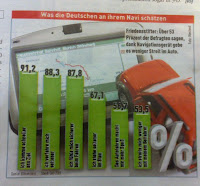 I came across this study in computer bild – you should not cite it as it in a scientific paper as “computer bild” – is consumer paper telling people mainly which computers to buy and how to use obvious features in software 😉
I came across this study in computer bild – you should not cite it as it in a scientific paper as “computer bild” – is consumer paper telling people mainly which computers to buy and how to use obvious features in software 😉
Nevertheless it is interesting and gave me some ideas what navigations systems are good for and it is another example that user needs on an abstract level (e.g. as in Maslows hierarchy of needs) could be interesting to inform designs.
If you do not read German here are the results in short:
- 91% faster to their destination
- 88% less often being lost
- 88% feel saver when driving with a SatNav
- 67% less often in traffic jams
- 57% driving is more fun
- 54% argue less in the car because of SatNav
If you want to cite it there is the original german press relese from BITKOM. It states that the study was based on about 500 people who drove themselfs with a navigation system sometime in the last to years. Probably there is a scientific paper with similar results…
